Memories of Follies at 50, With Original Stars Michael Misita, Kurt Peterson, and Marti Rolph
Three of the original “Young” counterparts look back on a now-historic production.
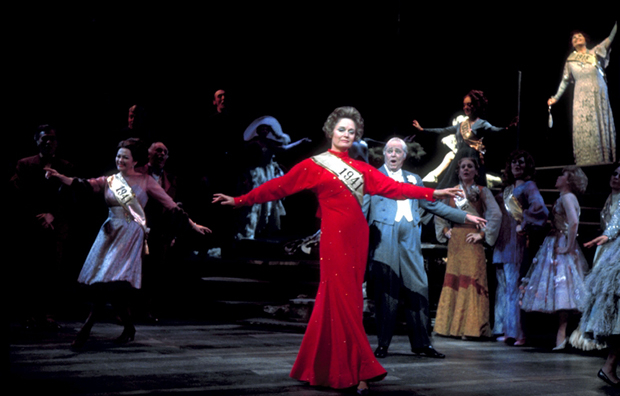
(© Martha Swope/New York Public Library for the Performing Arts)
Fifty years ago this weekend — April 4, 1971 — Stephen Sondheim and James Goldman's musical Follies opened at the Winter Garden Theatre. The production was a one-of-a-kind experience, codirected by Harold Prince and Michael Bennett, with Bennett doing choreography duties alongside associate Bob Avian, and a creative team filled with now-legendary names: Boris Aronson (sets), Florence Klotz (costumes), Tharon Musser (lighting), and Jonathan Tunick (orchestrations), among them.
Follies is set backstage at a Broadway theater scheduled for demolition, taking place during a reunion of all the performers of the Ziegfeld-esque "Weismann's Follies." At the center are two unhappily married couples — Buddy and Sally Plummer (Gene Nelson and Dorothy Collins) and Benjamin and Phyllis Stone (John McMartin and Alexis Smith) — whose memories come to life around them in the form of their younger selves. At the same time, several of the former showgirls, now aged — originally played by fading, but not faded, stars of the past — get up to sing their old numbers.
History views Follies as a pseudo-flop. Despite winning seven Tony Awards, it only ran for a little over a year. The second-most expensive Broadway production to date, it ultimately lost its entire investment. But in the ensuing decades, it has taken on a life of its own, with several of Sondheim's songs, namely, "Broadway Baby" and "I'm Still Here," becoming American standards, and a larger-than-life fanbase that's happy to dissect minutiae long into the night.
For original cast members Marti Rolph (Young Sally), Michael Misita (Young Vincent), and Kurt Peterson (Young Ben), to look back on the experience is a little bit like living the show itself. "I can close my eyes and think of so many specifics," Peterson says. "I often walk by the stage door and have such fond memories. I'm just glad they didn't make it a parking lot."
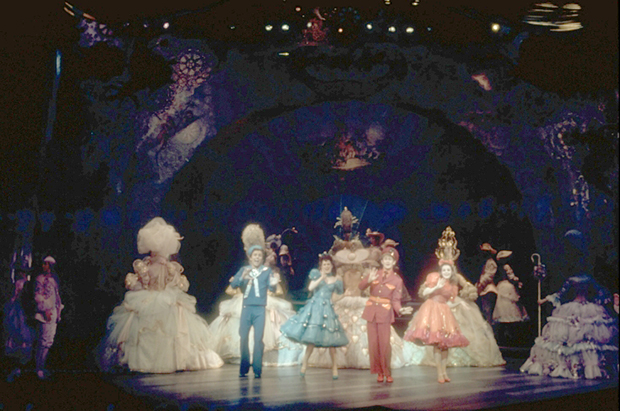
(© Martha Swope/New York Public Library for the Performing Arts)
These interviews have been condensed and edited for clarity.
How did you land your respective roles?
Marti Rolph: I was one of the last main characters that was hired, and Hal Prince told me much later that when I walked out on the stage to audition, they all said "There's Dorothy Collins" because we were so much alike. I was a 24-year-old kid from California, and it was my first time in New York, and I was so naïve.
Kurt Peterson: I think it's important to know that the four younger counterparts were cast because we were young and naïve. That's what the show was about — the follies of youth and not knowing where the choices were going to lead you. Only now do I have the knowledge that I was as unconscious as young Ben was in the show.
Michael Misita: I auditioned, just like everybody else, and then Graciela Daniele [Young Vanessa] wanted to see who she could dance with to do the "Bolero d'Amour." There may have been like 10 of us dancing with her, and Graciela looked up at me, smiled, and said "I want you." So that was that.
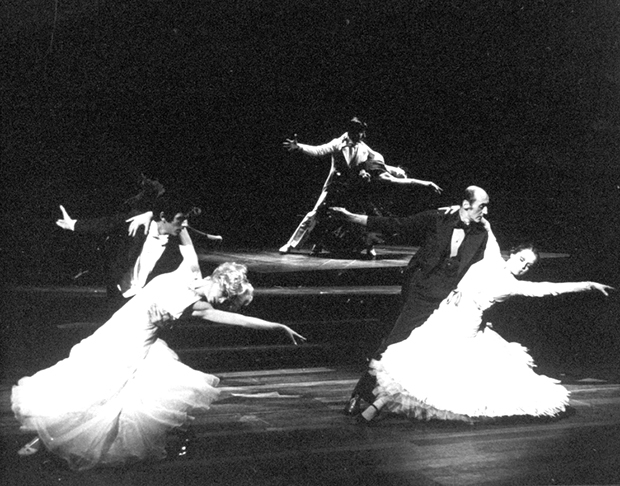
(© Martha Swope/New York Public Library for the Performing Arts)
Tell me about the rehearsal process.
Marti: It was magical, it really was. I thought all shows would be like that. It was the most amazing team of people, which I'm not sure I totally appreciated at the time. They were such geniuses.
Kurt: It was quite a team. To have Hal and Stephen Sondheim and Jonathan Tunick and Michael Bennett and Bob Avian, all in one place, in one show? Talk about getting spoiled. And afterwards, they went off in different directions and became the most creative people in musical-theater history.
Marti: One of my fondest memories was when we were at the Colonial Theatre in Boston, and Yvonne De Carlo [Carlotta] had been singing "Can That Boy Foxtrot," which they decided was too much of a one-joke song and wasn't working. They sent Stephen to the lounge and he wrote "I'm Still Here." Just comes back with something twice as good.
Michael: Working with Michael and Bob and Jonathan and Graciela on the "Bolero" was the way I loved to rehearse. Everyone else would leave and we'd spend an hour or two working it out and saw what felt right. I must say, Bob put that number together even more than Michael did. Originally, it was very different. It was slow and romantic and sensual, and then we'd go a little faster, and then we'd slow down. It was wonderful, and it was the first thing Hal wanted to cut out of the show. Michael fought for it. He told Hal "I'll leave." They compromised and made it faster, which kind of ruined it for us, compared to the original way. It was a little disappointing, but it was still a beautiful number.
Kurt: They had their disagreements, but we felt very taken care of by the creative staff. Hal was really like a father figure, and we all felt that security.
Marti: Michael and Hal really complemented each other. Hal had an absolutely amazing, spot-on focus and picture of what the whole show should be about, and Michael had an incredible sense of what it should be, too. Michael spent hours with us on how to look at somebody but look past them. They directed it almost like a movie, where one scene faded into another, with the past melting into the present. They just knew what they wanted, and the attention to detail was very specific.

(© Martha Swope/New York Public Library for the Performing Arts)
What were Dorothy Collins, Alexis Smith, John McMartin, and Gene Nelson like off stage?
Michael: Alexis and I hung around together a lot. She was hilarious and I just adored her. She started out being very frumpy. I remember her coming to rehearsal and she was wearing what I guess she thought people were supposed to wear, but we all thought "I thought she was more glamorous than this." Our friend Joey, who was her hair stylist, is the one that told her what to wear and how to be the star of the show.
Marti: I loved Dorothy. She was amazing, and I think because of the role, she was undervalued a little bit. She was valued by the team, by Steve and Hal and Michael, but she didn't have the flashy part like Alexis Smith. I didn't realize what an anchor she was until she was out once, and it became a different show. We were very much alike in some ways, even though she was a seasoned professional and I was a little kid, basically. There's a funny story, we were working on the mirror number ["Who's That Woman"] and I was struggling, and some of the older ladies were struggling. My refuge was the bathroom, where I'd hide for a few minutes and calm down. I went in once and heard someone in the next stall sobbing, and it turned out to be Dorothy. We were both in there, side by side sobbing. That bonded us in a funny way and we just became very, very good friends.
Michael: Gene Nelson was a doll. I'd watch his number every night and he'd say, "How was it tonight, Mike?" Because he never felt good in that number ["The God-Why-Don't-You-Love-Me Blues"]. People in the cast were basing everything they did on Ethel Shutta [Hattie], because she'd always get huge applause for her number ["Broadway Baby"]. And I don't think Gene ever felt like it was good enough.
Marti: John McMartin was one of the funniest people I ever met.
Kurt: John's sense of humor was incredible. His performance in Follies was Hal Prince's favorite performance by a man ever in a musical.
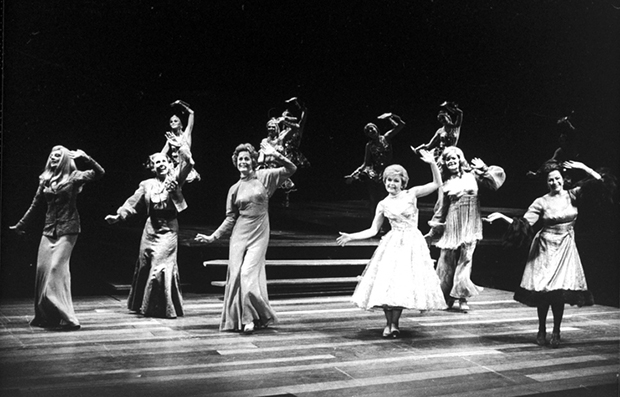
(© Martha Swope/New York Public Library for the Performing Arts)
And the elder statespeople of the cast?
Kurt: They were wonderful. Each one had a personality that was so distinct. That show was cast so brilliantly and could never be cast that way again. These people were those characters.
Marti: Ethel Shutta was a hoot. She was a riot.
Michael: She was like a grandma to us. She was the feistiest old girl, just as sweet as can be. And she hated her costume. She was like "That makes me look like an old lady," and I would laugh and say, "You are!" She had horrible arthritis and could barely walk. She was in a lot of pain. You wouldn't know it when she was on stage, of course.
Marti: They were all very special. Justine Johnston [Heidi] was beautiful. Mary McCarty [Stella] was another hoot.
Michael: Fifi D'Orsay [Solange] was nuts. Her dressing room was all pictures of herself.
Kurt: I wish I had done a little bit more research back then to find out their incredible histories. Knowing Yvonne De Carlo, from her film career, to The Munsters, to then, and then seeing that song Steve wrote for her, "I'm Still Here," the lyric "Career from career to career" was so spot on. And Ethel used some of the same choreography in "Broadway Baby" that she used in the 1930 movie Whoopee! If I had known that back then, I would have died. I could have learned so much and talked with them about what it was like.

(© Martha Swope/New York Public Library for the Performing Arts)
At what point did you realize that Follies had taken on a life of its own, in terms of the fandom?
Marti: I had no inkling of it until recently, honestly, until the Fans of Follies Facebook group was created. It's weird, it really has taken on a life of its own.
Michael: I never even brought it up for years and years, because once I finished it, I was onto other things. Sometimes, people would go "Aren't you Michael Misita? Weren't you in Follies?" and I'd go "Oh, yeah" and they'd say, "It's my favorite show ever" and I was a little taken aback. I had no idea it affected people to that degree.
Kurt: Whenever someone would see me, they'd say, "You were in Follies" and I'd say "I sure was," so I've grown to know how important it is.
Marti: When we were running, people would see the show and either love it and come back 12 times or despise it. Nobody was "Meh" about it. And the people who loved it have carried it on.
Kurt: I had left the show to do On the Town and that didn't turn out so well, so I came back to do the final performance of Follies, and all of those people who'd seen it six or seven times came back and gave us an ovation that was incredible.
Michael: People know so much more about it than I do, which amazes me. I think it's kind of cool. I just like to read [the chatrooms] when they're arguing about what belt so and so wore in the second act.
Marti: I've seen other productions of this show. Some of them have been successful; the one at Paper Mill was lovely; and then I saw one somewhere which was hilarious, because it wasn't even close. But you'll never be able to do it like it was. We're more appreciative of it now, in a way, than we were back then. I was in awe of how beautiful it was. You always had a sense of "oh, wow." I don't think that will ever be repeated.
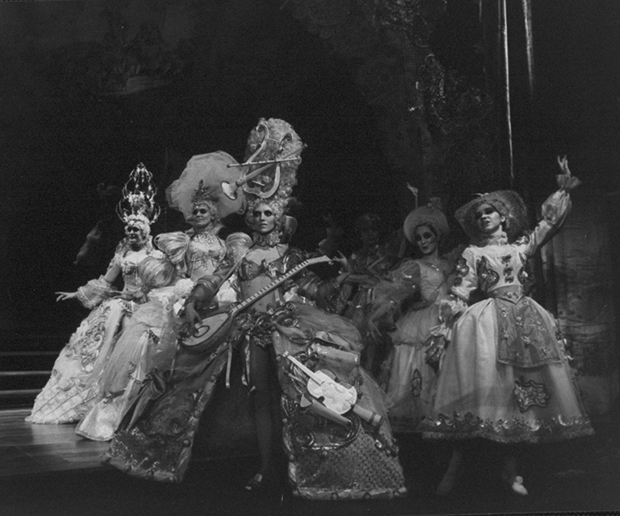
(© Martha Swope/New York Public Library for the Performing Arts)







